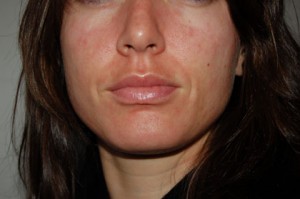
Rosacea is a chronic condition classified within the acne family, but can be differentiated from acne by a few features:
Although rosacea is slightly more common in women aged 30-50, men this same age tend to suffer its more severe forms that include scarring and a bulbous nose known as rhinophyma. The most common form of rosacea is the mildest and also the hardest to treat. Small blood vessels cover the cheeks, but pimples and papules are rare. This “erythmogenic” form doesn’t usually respond to pharmaceutical treatments and requires our pulse dye laser to combat effectively. The pulse dye laser heats up these blood vessels so rapidly that they spasm and shrink from view.
The cause of rosacea is unknown, but theories abound. Older literature suggests that rosacea may be secondary to a familial predisposition to inappropriately vasodilate (expand) vessels close to the skin in response to certain stimuli. This theory places small nerves located around these blood vessels at the center of the rosacea discussion. Other experts believe that the same bacterium that causes acne (P. acnes) is at the source of rosacea flare-ups. Newer literature, most notably from Japan, posits small mites, called Demodex (shown below), as the cause for unnecessary inflammation near the skin’s surface.
No matter the cause, rosacea that goes untreated can lead to disfiguring scars and a bulbous nose known as rhinophyma. And while there’s no cure for rosacea, there are some amazing therapies available at our office to get your rosacea cleared up fast.
Topical Agents like metronidazole and sulfa agents target the mite and the bacteria thought to contribute to rosacea. New agents cause vasoconstriction of small blood vessels in an effort to mitigate facial redness.
Oral Agents like antibiotics or isotretinoin work against the inflammation associated rosacea as well as the pathogens behind it.
Lasers, like our pulse dye, shrink small blood vessels painlessly from view.
If you have a tendency to blush, come on in and let’s have a look. We’ll custom tailor your daily care regimen for a safe, effective solution to your rosacea.